SCLERODERMA and Calcinosis & Raynaud’s
Calcinosis Thumb and 3rd Digit - External
X-Ray of right Hand & Wrist Internal Calcinosis
Below are photos and x-rays of the calcinosis of my actual hand.
Click on the photos for larger view.

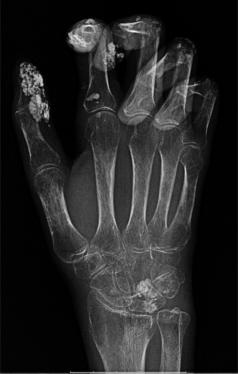
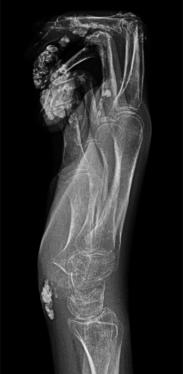
Many people with scleroderma develop white lumps under the skin of their fingers or other parts of the
body, known as calcium deposits or calcinosis. These can range in size from small specks to collections
as large as tennis balls. A number of causes for these calcium deposits have been suggested, including a
lack of oxygen being delivered to the skin, chronic inflammation of the vessels, and an imbalance of
components that regulate the amount of calcium entering skin cells. However, it is unclear exactly how
these problems result in calcinosis. Calcium deposits are very painful, and can interfere with function-
ing, especially when they form on the hands. Sometimes the deposits can break through the skin and
drain white material, which may lead to an ulcer or infection. Ulcers incured from hardening of the
calcinosis which can cause open sores and infection as well. In this case, it is important to consult a
physician, who may prescribe antibiotics.
I have been dealing with calcinosis in my hands for some years and more recently my arms and elbows.
The deposits for me seem to develop at any pressure points. The calcinosis deep below the skin I believe
starts in liquid form, then transforms to solid as it move through the tissue. Once it is in solid form it is
like sharp bone or glass which can be traumatic to the fingers in sores and pain. There isn’t any
medication that has proven to prevent, slow or reverse calcinosis at this time. I participated in a trial at
Stanford University for a drug call Orenitram that has finished and the results should be published
soon. I was not successful with it because once I increased to higher levels of the medication, my
digestive system which is compromised could not tolerate higher levels of oral medication. (more pills).
I did see remarkable improvement in circulation and raynauds until I had to decrease the dosage.
The best care that has allowed me to take care of my fingers with the calcinosis is through the wound
clinic at Jamestown Regional Medical Center. My specialist Amanda Lausch is very informed on
scleroderma, and has worked with me to not only provide top care through standard Healogics
practices, but to tailor my care for me as well as train me to assist in my own personal care. Not all
wound clinics are the same. I recommend you find a certified Healogics facility and specialist.
Raynaud’s phenomenon affects roughly 95% of people with scleroderma. Raynaud’s phenomenon is
characterized by so-called attacks that usually occur in response to cold temperatures or sudden drops
in temperature. During a Raynaud’s attack, small blood vessels in the fingers (and, less frequently, the
toes, ears, nose, and even tongue) suddenly clamp down. The fingers typically turn white as blood flow
is decreased, then blue – meaning that the finger does not have enough oxygen – and then red as blood
flows back into the fingers. During a Raynaud’s attack, people may experience a number of uncomfort-
able sensations, including cold, numbness and pins and needles, followed by burning, throbbing, and
pain as circulation returns to normal. The most effective way to manage Raynaud’s is to maintain a
warm core temperature (e.g. wear layers, shawls, hats, etc.) and to avoid possible triggers for attacks,
such as cold temperatures or sudden drops in temperature, smoking, and certain medications.
What you can do:
•
Avoid cold temperatures and sudden drops in temperature: Dress in layers of clothing to keep the
body core warm. Keep your fingers warm with mittens, gloves, and electric/chemical hand warmers
for extra warmth. Use insulated drinking containers. If you are getting an iced beverage, place a
napkin or a drink sleeve over the cup. Try to avoid sudden changes in temperature, such as jumping
into cold water or being abruptly exposed to air-conditioning in the summer.
•
Avoid vaso-constricting drugs: Certain drugs can worsen Raynaud's by causing the blood vessels to
spasm and constrict. These include: beta-blockers prescribed for hypertension or heart disease,
amphetamines, migraine medications containing ergotamine or serotonin-receptor antagonists,
some attention deficit disorder medications, diet pills, herbs containing ephedra, and nasal drops or
sprays prescribed for rhinitis or flu.
•
Stop smoking: Regular cigarette smokers are known to have reduced blood flow to their fingers and
toes, and there is strong clinical evidence that smoking cessation is associated with improvement in
Raynaud’s. There are many other health benefits associated with smoking cessation. If you smoke,
talk to your physician about programs that can help you quit. Similar adverse effects on digital
blood flow occur as a result of marijuana consumption.
•
Reduce emotional stress: There is no strong clinical evidence to support the link between Raynaud’s
and emotional stress. Nonetheless, since ongoing stress is thought to narrow the blood vessels,
practicing stress management skills like relaxation may be beneficial over time.
•
Ask your physician about medications: In addition to avoiding triggers, some medications like
calcium channel blockers are helpful for preventing attacks. Consult your physician about whether
these medications are right for you.
•
When a Raynaud’s attack does occur, try warming up your hands by holding them under warm
water, or placing them on a heater or a hot water bottle. If you do not have access to one, you can
also put your hand under your armpits to warm them, rub your hands together, or rotate your arms
in a windmill pattern to increase circulation.

Stage 3- Red
Increased Blood Flow
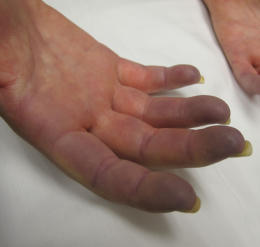
Stage 1 - White
Decreased Blood Flow
Stage 2 - Blue
Decreased Oxygen
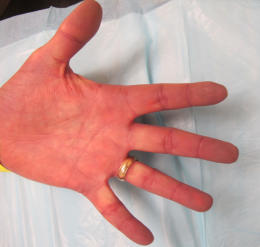
The Stages of Raynaud’s Attack
Many people with scleroderma develop
white lumps under the skin of their fingers
or other parts of the body, known as cal-
cium deposits or calcinosis. These can range
in size from small specks to collections as
large as tennis balls. A number of causes for
these calcium deposits have been suggested,
including a lack of oxygen being delivered
to the skin, chronic inflammation of the ves-
sels, and an imbalance of components that
regulate the amount of calcium entering
skin cells. However, it is unclear exactly
how these problems result in calcinosis.
Calcium deposits are very painful, and can
interfere with functioning, especially when
they form on the hands. Sometimes the de-
posits can break through the skin and drain
white material, which may lead to an ulcer
or infection. Ulcers incured from hardening
of the calcinosis which can cause open sores
and infection as well. In this case, it is im-
portant to consult a physician, who may
prescribe antibiotics.
I have been dealing with calcinosis in my
hands for some years and more recently my
arms and elbows. The deposits for me seem
to develop at any pressure points. The calci-
nosis deep below the skin I believe starts in
liquid form, then transforms to solid as it
move through the tissue. Once it is in solid
form it is like sharp bone or glass which can
be traumatic to the fingers in sores and
pain. There isn’t any medication that has
proven to prevent, slow or reverse calci-
nosis at this time. I participated in a trial at
Stanford University for a drug call Oren-
itram that has finished and the results
should be published soon. I was not success-
ful with it because once I increased to
higher levels of the medication, my diges-
tive system which is compromised could
not tolerate higher levels of oral medica-
tion. (more pills). I did see remarkable
improvement in circulation and raynauds
until I had to decrease the dosage.
The best care that has allowed me to take
care of my fingers with the calcinosis is
through the wound clinic at Jamestown Re-
gional Medical Center. My specialist
Amanda Lausch is very informed on sclero-
derma, and has worked with me to not only
provide top care through standard Healog-
ics practices, but to tailor my care for me as
well as train me to assist in my own per-
sonal care. Not all wound clinics are the
same. I recommend you find a certified
Healogics facility and specialist.
SCLERODERMA and Calcinosis & Raynauds
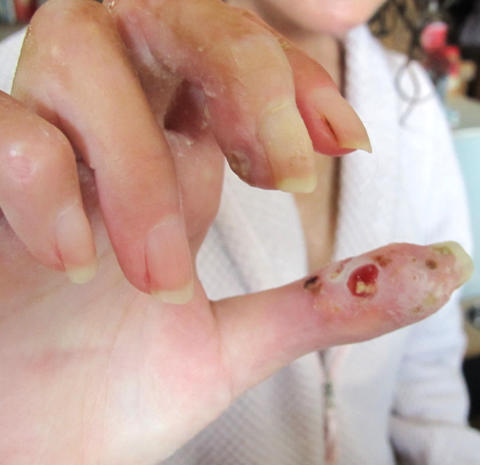


Below are photos and x-rays of the calcinosis of my
actual hand. Click on the photos for larger view.
Calcinosis Thumb and 3rd Digit - External
X-Ray of Right Hand & Wrist internal Calcinosis
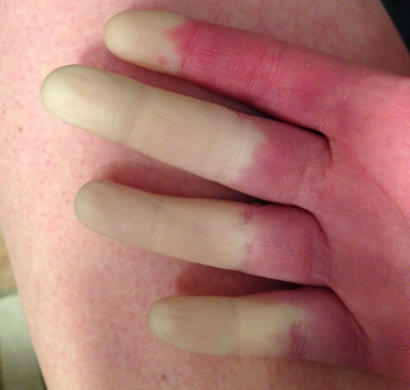
Stage 3- Red
Increased Blood Flow
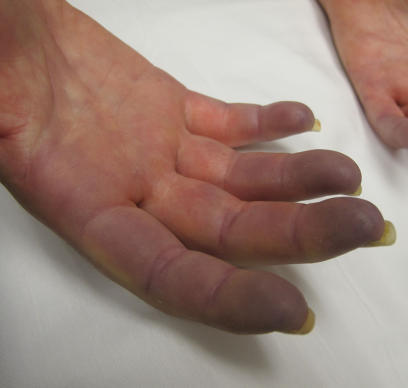
Stage 1 - White
Decreased Blood Flow
Stage 2 - Blue
Decreased Oxygen
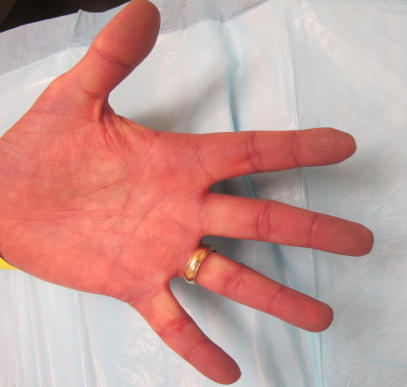
The Stages of Raynaud’s Attack
Raynaud’s phenomenon affects roughly
95% of people with scleroderma. Ray-
naud’s phenomenon is characterized by so-
called attacks that usually occur in
response to cold temperatures or sudden
drops in temperature. During a Raynaud’s
attack, small blood vessels in the fingers
(and, less frequently, the toes, ears, nose,
and even tongue) suddenly clamp down.
The fingers typically turn white as blood
flow is decreased, then blue – meaning that
the finger does not have enough oxygen –
and then red as blood flows back into the
fingers. During a Raynaud’s attack, people
may experience a number of uncomfort-
able sensations, including cold, numbness
and pins and needles, followed by burning,
throbbing, and pain as circulation returns
to normal. The most effective way to man-
age Raynaud’s is to maintain a warm core
temperature (e.g. wear layers, shawls, hats,
etc.) and to avoid possible triggers for at-
tacks, such as cold temperatures or
sudden drops in temperature, smoking,
and certain medications.
What you can do:
•
Avoid cold temperatures and sudden
drops in temperature: Dress in layers of
clothing to keep the body core warm.
Keep your fingers warm with mittens,
gloves, and electric/chemical hand
warmers for extra warmth. Use insu-
lated drinking containers. If you are
getting an iced beverage, place a nap-
kin or a drink sleeve over the cup. Try
to avoid sudden changes in tempera-
ture, such as jumping into cold water
or being abruptly exposed to air-condi-
tioning in the summer.
•
Avoid vaso-constricting drugs: Certain
drugs can worsen Raynaud's by causing
the blood vessels to spasm and con-
strict. These include: beta-blockers
prescribed for hypertension or heart
disease, amphetamines, migraine medi-
cations containing ergotamine or
serotonin-receptor antagonists, some
attention deficit disorder medications,
diet pills, herbs containing ephedra,
and nasal drops or sprays prescribed
for rhinitis or flu.
•
Stop smoking: Regular cigarette smok-
ers are known to have reduced blood
flow to their fingers and toes, and there
is strong clinical evidence that smoking
cessation is associated with improve-
ment in Raynaud’s. There are many
other health benefits associated with
smoking cessation. If you smoke, talk to
your physician about programs that
can help you quit. Similar adverse ef-
fects on digital blood flow occur as a
result of marijuana consumption.
•
Reduce emotional stress: There is no
strong clinical evidence to support the
link between Raynaud’s and emotional
stress. Nonetheless, since ongoing
stress is thought to narrow the blood
vessels, practicing stress management
skills like relaxation may be beneficial
over time.
•
Ask your physician about medications:
In addition to avoiding triggers, some
medications like calcium channel
blockers are helpful for preventing at-
tacks. Consult your physician about
whether these medications are right for
you.
•
When a Raynaud’s attack does occur,
try warming up your hands by holding
them under warm water, or placing
them on a heater or a hot water bottle.
If you do not have access to one, you
can also put your hand under your
armpits to warm them, rub your hands
together, or rotate your arms in a wind-
mill pattern to increase circulation.




















